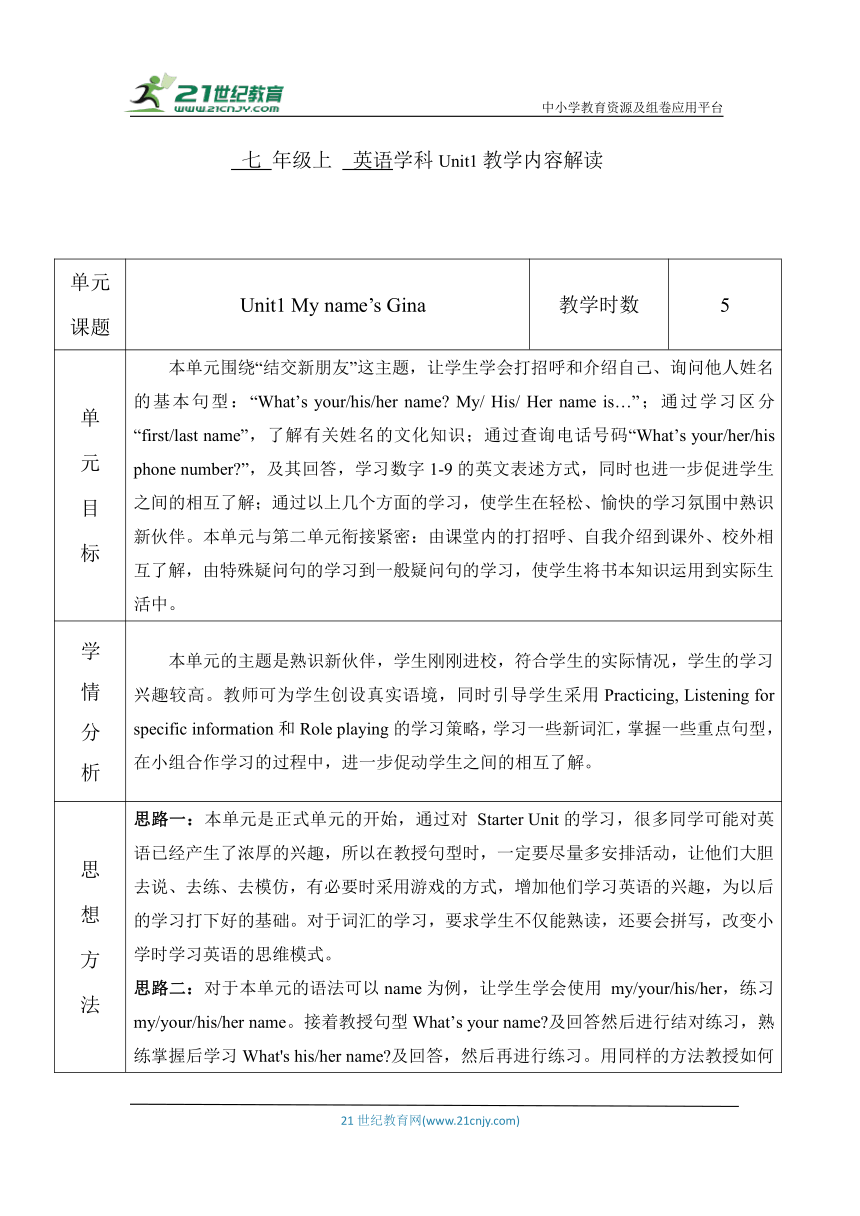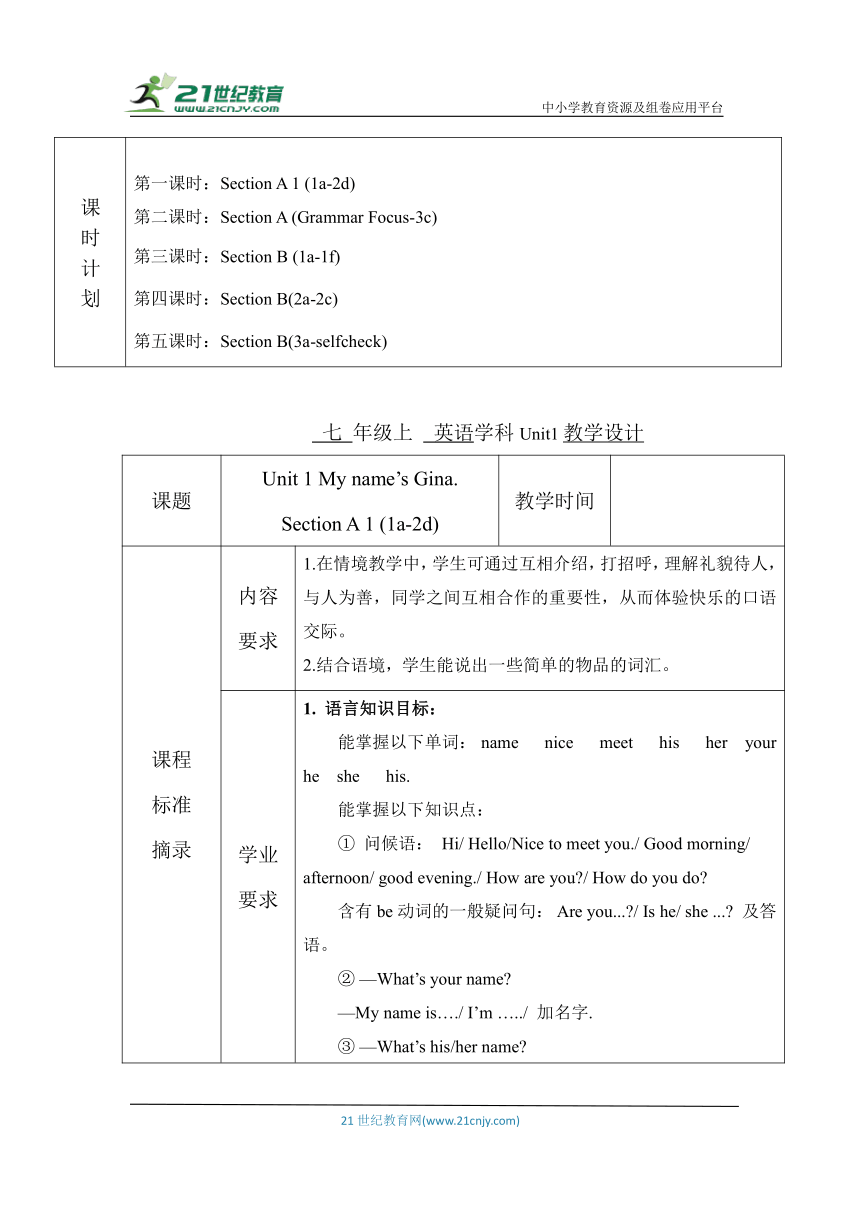核心素养目标Unit 1 My name's Gina. Section A 1 (1a-2d)单元整体教学设计
文档属性
| 名称 | 核心素养目标Unit 1 My name's Gina. Section A 1 (1a-2d)单元整体教学设计 |  | |
| 格式 | docx | ||
| 文件大小 | 637.4KB | ||
| 资源类型 | 试卷 | ||
| 版本资源 | 人教新目标(Go for it)版 | ||
| 科目 | 英语 | ||
| 更新时间 | 2023-09-08 15:08:22 | ||
图片预览



文档简介
中小学教育资源及组卷应用平台
七 年级上 英语学科Unit1教学内容解读
单元课题 Unit1 My name’s Gina 教学时数 5
单 元 目 标 本单元围绕“结交新朋友”这主题,让学生学会打招呼和介绍自己、询问他人姓名的基本句型:“What’s your/his/her name My/ His/ Her name is…”;通过学习区分“first/last name”,了解有关姓名的文化知识;通过查询电话号码“What’s your/her/his phone number ”,及其回答,学习数字1-9的英文表述方式,同时也进一步促进学生之间的相互了解;通过以上几个方面的学习,使学生在轻松、愉快的学习氛围中熟识新伙伴。本单元与第二单元衔接紧密:由课堂内的打招呼、自我介绍到课外、校外相互了解,由特殊疑问句的学习到一般疑问句的学习,使学生将书本知识运用到实际生活中。
学 情 分 析 本单元的主题是熟识新伙伴,学生刚刚进校,符合学生的实际情况,学生的学习兴趣较高。教师可为学生创设真实语境,同时引导学生采用Practicing, Listening for specific information和Role playing的学习策略,学习一些新词汇,掌握一些重点句型,在小组合作学习的过程中,进一步促动学生之间的相互了解。
思 想 方 法 思路一:本单元是正式单元的开始,通过对 Starter Unit的学习,很多同学可能对英语已经产生了浓厚的兴趣,所以在教授句型时,一定要尽量多安排活动,让他们大胆去说、去练、去模仿,有必要时采用游戏的方式,增加他们学习英语的兴趣,为以后的学习打下好的基础。对于词汇的学习,要求学生不仅能熟读,还要会拼写,改变小学时学习英语的思维模式。 思路二:对于本单元的语法可以name为例,让学生学会使用 my/your/his/her,练习 my/your/his/her name。接着教授句型What’s your name 及回答然后进行结对练习,熟练掌握后学习What's his/her name 及回答,然后再进行练习。用同样的方法教授如何询问及回答电话号码。在学习中要注意动词的缩写形式。 思路三:本单元的话题是“交新朋友”,因此,在教学中介绍自己和询问及回答电话号码中可以创设情境让学生体会到学习英语的乐趣,并且达到“学以致用”的效果。当然还可以通过进行名字结对游戏、建立电话簿、制作身份证等,来巩固所学的知识。
单 元 知 识 框 架
课 时 计 划 第一课时:Section A 1 (1a-2d) 第二课时:Section A (Grammar Focus-3c) 第三课时:Section B (1a-1f) 第四课时:Section B(2a-2c) 第五课时:Section B(3a-selfcheck)
七 年级上 英语学科Unit1教学设计
课题 Unit 1 My name’s Gina. Section A 1 (1a-2d) 教学时间
课程 标准 摘录 内容 要求 1.在情境教学中,学生可通过互相介绍,打招呼,理解礼貌待人,与人为善,同学之间互相合作的重要性,从而体验快乐的口语交际。 2.结合语境,学生能说出一些简单的物品的词汇。
学业 要求 1. 语言知识目标: 能掌握以下单词: name nice meet his her your he she his. 能掌握以下知识点: ① 问候语: Hi/ Hello/Nice to meet you./ Good morning/ afternoon/ good evening./ How are you / How do you do 含有be动词的一般疑问句: Are you... / Is he/ she ... 及答语。 ② —What’s your name —My name is…./ I’m …../ 加名字. ③ —What’s his/her name —His/ Her name is…./ He/ She is …../ 加名字. ④ Ms/ Miss/ Mrs/ Mr. 2. 技能目标: 能正确使用问候语,自我介绍及询问他人姓名(第二、三人称),并作出相应回答。
教学 提示 通过学习,培养学生日常交际的能力,学生能正确介绍自己并能礼貌的问候他人。引导他们礼貌待人,与他人和睦相处。
核心 素养 目标 语言能力:能够介绍自己,并问候他人。在情境交际中,学生可通过互相介绍,打招呼,理解礼貌待人,与人为善,同学之间互相合作的重要性从而体验快乐的口语交际。 学习能力:通过教学使学生对英语产生强烈的兴趣和愿望,乐于参加各种语言实践活动。能与伙伴团结一致、友好相处,学会如何礼貌地与他人交往。
教学 重难点 1. 教学重点: 1) 让学生学会自我介绍并询问他人姓名。 2) 正确使用问候语。 2. 教学难点: 区分Ms/Miss/Mrs/Mr 和your形容词性物主代词的简单用法。
教学过程设计
Step Ⅰ: Revision (2’) 1. Dictate 5 vowel letters “Aa, Ee, Ii, Oo, Uu” 2. Use some objects and make a game : --What’s this in English --It’s a/an _____________ . --Spell it, please . -- ___________________ . Step Ⅱ: Lead-in (3’) T: The new term begins. Everyone will meet many new classmates. Do you want to make friends with them if your answer is “yes”, please introduce yourself in your group . S1: Hello! I’m Han Mei. What’s your name S2: My name’s Li Lei. Nice to meet you. S1: Nice to meet you, too. And what’s your name, please S3: Lui Li. How do you do S1: How do you do StepⅢ: Listening (5’) Listen and number the conversations. T:Today I have good news for you. Three new students will come to our class. They are from other places. Do you want to know them Let’s listen to the recording of 1b in section A. Play the recording for the first time. Students only listen. Play the recording again. Students listen and write a number in the box next to each conversation. Then check the answers with the whole class. ( This activity develops students listening skill.) StepⅣ: Practicing (8’) T: Now everyone has some new friends. Do you want others to know them Do you want more friends Let’s introduce our new friends to others. OK Ss: OK. S1: This is my new friend. His name is…… S2: Hello,…… Nice to meet you. S3: Nice to meet you, too. Look! This is my new friends. Her name is…… Ss: How do you do S4: How do you do StepV: Listening(2a, 2b) (8’) 1. Let students listen to the tape and number the picture 1—4. T: Yesterday I made a new friend. Her name is Jenny. She is very lovely. She introduces many of hers to me. Do you want to know about them Let’s listen to the tape and find out some useful information. ( Students listen to the tape and give the right answers.) Play the recording for the first time, students only listen. Play the recording again, students listen and write a number in the box next to the pictures. Check the answers with the whole class. 2. Let students to the conversations again and circle the names they hear. Check the answers. (This activity not only provides practice in the target languages but also teaches the students to listen to special information in conversations.) StepⅥ: Practicing (5’) 1. Encourage students to practice the dialogues. T: Now you’ve known something about introductions and greetings. But if you are in other places, how do you introduce yourself and greet others Example: (At a party) S1: Hello! I’m Grace. What’s your name S2: My name is Cindy. Jim’s friend. Nice to meet you. 2. Ask some to act out their dialogues one by one. StepⅦ: Summary (2’) In this class, we’ve learned the key vocabularies and the target languages. And we also know the differences between Chinese names and English names. StepⅨ:Homework Make a conversation
教学反思
21世纪教育网(www.21cnjy.com)
七 年级上 英语学科Unit1教学内容解读
单元课题 Unit1 My name’s Gina 教学时数 5
单 元 目 标 本单元围绕“结交新朋友”这主题,让学生学会打招呼和介绍自己、询问他人姓名的基本句型:“What’s your/his/her name My/ His/ Her name is…”;通过学习区分“first/last name”,了解有关姓名的文化知识;通过查询电话号码“What’s your/her/his phone number ”,及其回答,学习数字1-9的英文表述方式,同时也进一步促进学生之间的相互了解;通过以上几个方面的学习,使学生在轻松、愉快的学习氛围中熟识新伙伴。本单元与第二单元衔接紧密:由课堂内的打招呼、自我介绍到课外、校外相互了解,由特殊疑问句的学习到一般疑问句的学习,使学生将书本知识运用到实际生活中。
学 情 分 析 本单元的主题是熟识新伙伴,学生刚刚进校,符合学生的实际情况,学生的学习兴趣较高。教师可为学生创设真实语境,同时引导学生采用Practicing, Listening for specific information和Role playing的学习策略,学习一些新词汇,掌握一些重点句型,在小组合作学习的过程中,进一步促动学生之间的相互了解。
思 想 方 法 思路一:本单元是正式单元的开始,通过对 Starter Unit的学习,很多同学可能对英语已经产生了浓厚的兴趣,所以在教授句型时,一定要尽量多安排活动,让他们大胆去说、去练、去模仿,有必要时采用游戏的方式,增加他们学习英语的兴趣,为以后的学习打下好的基础。对于词汇的学习,要求学生不仅能熟读,还要会拼写,改变小学时学习英语的思维模式。 思路二:对于本单元的语法可以name为例,让学生学会使用 my/your/his/her,练习 my/your/his/her name。接着教授句型What’s your name 及回答然后进行结对练习,熟练掌握后学习What's his/her name 及回答,然后再进行练习。用同样的方法教授如何询问及回答电话号码。在学习中要注意动词的缩写形式。 思路三:本单元的话题是“交新朋友”,因此,在教学中介绍自己和询问及回答电话号码中可以创设情境让学生体会到学习英语的乐趣,并且达到“学以致用”的效果。当然还可以通过进行名字结对游戏、建立电话簿、制作身份证等,来巩固所学的知识。
单 元 知 识 框 架
课 时 计 划 第一课时:Section A 1 (1a-2d) 第二课时:Section A (Grammar Focus-3c) 第三课时:Section B (1a-1f) 第四课时:Section B(2a-2c) 第五课时:Section B(3a-selfcheck)
七 年级上 英语学科Unit1教学设计
课题 Unit 1 My name’s Gina. Section A 1 (1a-2d) 教学时间
课程 标准 摘录 内容 要求 1.在情境教学中,学生可通过互相介绍,打招呼,理解礼貌待人,与人为善,同学之间互相合作的重要性,从而体验快乐的口语交际。 2.结合语境,学生能说出一些简单的物品的词汇。
学业 要求 1. 语言知识目标: 能掌握以下单词: name nice meet his her your he she his. 能掌握以下知识点: ① 问候语: Hi/ Hello/Nice to meet you./ Good morning/ afternoon/ good evening./ How are you / How do you do 含有be动词的一般疑问句: Are you... / Is he/ she ... 及答语。 ② —What’s your name —My name is…./ I’m …../ 加名字. ③ —What’s his/her name —His/ Her name is…./ He/ She is …../ 加名字. ④ Ms/ Miss/ Mrs/ Mr. 2. 技能目标: 能正确使用问候语,自我介绍及询问他人姓名(第二、三人称),并作出相应回答。
教学 提示 通过学习,培养学生日常交际的能力,学生能正确介绍自己并能礼貌的问候他人。引导他们礼貌待人,与他人和睦相处。
核心 素养 目标 语言能力:能够介绍自己,并问候他人。在情境交际中,学生可通过互相介绍,打招呼,理解礼貌待人,与人为善,同学之间互相合作的重要性从而体验快乐的口语交际。 学习能力:通过教学使学生对英语产生强烈的兴趣和愿望,乐于参加各种语言实践活动。能与伙伴团结一致、友好相处,学会如何礼貌地与他人交往。
教学 重难点 1. 教学重点: 1) 让学生学会自我介绍并询问他人姓名。 2) 正确使用问候语。 2. 教学难点: 区分Ms/Miss/Mrs/Mr 和your形容词性物主代词的简单用法。
教学过程设计
Step Ⅰ: Revision (2’) 1. Dictate 5 vowel letters “Aa, Ee, Ii, Oo, Uu” 2. Use some objects and make a game : --What’s this in English --It’s a/an _____________ . --Spell it, please . -- ___________________ . Step Ⅱ: Lead-in (3’) T: The new term begins. Everyone will meet many new classmates. Do you want to make friends with them if your answer is “yes”, please introduce yourself in your group . S1: Hello! I’m Han Mei. What’s your name S2: My name’s Li Lei. Nice to meet you. S1: Nice to meet you, too. And what’s your name, please S3: Lui Li. How do you do S1: How do you do StepⅢ: Listening (5’) Listen and number the conversations. T:Today I have good news for you. Three new students will come to our class. They are from other places. Do you want to know them Let’s listen to the recording of 1b in section A. Play the recording for the first time. Students only listen. Play the recording again. Students listen and write a number in the box next to each conversation. Then check the answers with the whole class. ( This activity develops students listening skill.) StepⅣ: Practicing (8’) T: Now everyone has some new friends. Do you want others to know them Do you want more friends Let’s introduce our new friends to others. OK Ss: OK. S1: This is my new friend. His name is…… S2: Hello,…… Nice to meet you. S3: Nice to meet you, too. Look! This is my new friends. Her name is…… Ss: How do you do S4: How do you do StepV: Listening(2a, 2b) (8’) 1. Let students listen to the tape and number the picture 1—4. T: Yesterday I made a new friend. Her name is Jenny. She is very lovely. She introduces many of hers to me. Do you want to know about them Let’s listen to the tape and find out some useful information. ( Students listen to the tape and give the right answers.) Play the recording for the first time, students only listen. Play the recording again, students listen and write a number in the box next to the pictures. Check the answers with the whole class. 2. Let students to the conversations again and circle the names they hear. Check the answers. (This activity not only provides practice in the target languages but also teaches the students to listen to special information in conversations.) StepⅥ: Practicing (5’) 1. Encourage students to practice the dialogues. T: Now you’ve known something about introductions and greetings. But if you are in other places, how do you introduce yourself and greet others Example: (At a party) S1: Hello! I’m Grace. What’s your name S2: My name is Cindy. Jim’s friend. Nice to meet you. 2. Ask some to act out their dialogues one by one. StepⅦ: Summary (2’) In this class, we’ve learned the key vocabularies and the target languages. And we also know the differences between Chinese names and English names. StepⅨ:Homework Make a conversation
教学反思
21世纪教育网(www.21cnjy.com)
同课章节目录
- starters 预备篇(2012秋审查)
- Unit 1 Good morning !
- Unit 2 What’s this in English?
- Unit 3 What color is it ?
- Unit 1 My name's Gina.
- Section A
- Section B
- Unit 2 This is my sister.
- Section A
- Section B
- Unit 3 Is this your pencil?
- Section A
- Section B
- Unit 4 Where's my schoolbag?
- Section A
- Section B
- Unit 5 Do you have a soccer ball?
- Section A
- Section B
- Unit 6 Do you like bananas?
- Section A
- Section B
- Unit 7 How much are these socks?
- Section A
- Section B
- Unit 8 When is your birthday?
- Section A
- Section B
- Unit 9 My favorite subject is science.
- Section A
- Section B
